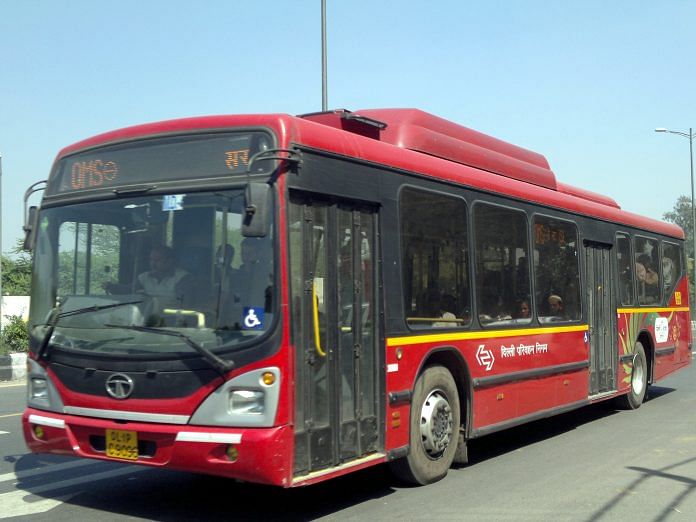As per Master Plan 2021, DTC is short by 10,000 buses. Congress didn’t buy after CWG, AAP promised 10,000, but floor height issue has stalled the process.
When the smog in the National Capital Region started choking the populace, it was only a matter of time before the Aam Aadmi Party government in Delhi brought back the third edition of its odd-even scheme for vehicles. And it did, announcing that the policy would be enforced (with the usual exemptions) from 13 to 17 November.
To ease the pain of the public, it also announced that 500 buses would be hired from private operators to supplement the Delhi Transport Corporation’s fleet. But the truth is 500 buses is not even the tip of the iceberg when it comes to the size of the public transport problem in Delhi. By 2021, Delhi needs 15,000 buses on the roads; it currently has just over 5,000.
The necessity
“The Master Plan for Delhi, 2021, recommends the modal share of public transport to be 80 per cent,” Anu Soman, research associate at the Centre for Science and Environment, told ThePrint.
“As per the CSE’s calculations, that requires a fleet size of 15,000 buses, after accounting for the estimated ridership of Delhi Metro (including Phase IV). Thus, based on various estimates, there’s currently a shortfall of roughly 10,000 buses in Delhi.”

Since the Commonwealth Games in the city in 2010, the DTC has not procured a single bus, while only 215 of the 736 cluster buses (orange buses bearing the ‘Delhi Transit’ branding) have been introduced so far. AAP, in its election manifesto, had promised the procurement of 10,000 buses, but hasn’t delivered on this promise so far.
The Supreme Court had intervened in the matter of procurement of buses in 1998, and then again in 2016, directing the Delhi government to hasten the process. The Delhi High Court, too, in 2007, had asked the government to augment the DTC fleet by 11,000 buses.
Then, on 4 April this year, the Environment Pollution (Prevention & Control) Authority (EPCA) allotted responsibility to the transport department of Delhi, the DTC, the Delhi Integrated Multi-Modal Transit System and the Delhi Development Authority to adhere to the SC’s order and increase the fleet size.
And yet, the game of bureaucratic football continued over the procurement process, with the point of disagreement being the floor height of the buses.
Low-floor versus standard-floor
At the beginning of November, the DTC put out an expression of interest (EOI) for procuring 1,000 new buses. According to DTC officials, the low-floor bus experiment in the city is over, with the EOI being for non-AC, standard floor (900mm), CNG buses.
Officials told ThePrint that they expected the whole procurement process for these buses to be completed by December. However, on the basis of what has transpired since 2010, there doesn’t seem to be much cause for optimism.
Nagender Sharma, media coordinator for the Delhi government, told ThePrint that low-floor buses were one of the key reasons why the procurement process was stalled.
“Only two companies, Tata and Ashok Leyland, provide low-floor CNG buses. They demand a very high maintenance cost,” he said. “The process had got stuck there, but the DTC has sorted this out. Very soon, we will have new buses.”
The DTC’s low-floor fleet is increasingly unreliable – on an average, about 500 big and small problems are reported in the buses every day. Experts say the buses, introduced ahead of the Commonwealth Games, had inherent manufacturing defects.
“Low-floor, low-entry buses have been a disaster in terms of cost maintenance and efficiency,” said Rakesh Sethi, an expert at the Indian Foundation of Transport Research and Training.
Sethi recalled that in 2013, a demand was made for the buses to be recalled by the manufacturers and replaced by those competent to run on Delhi roads. He also said that their maintenance has proven to be a bigger challenge through time, because third-party repairs of these buses have proven inefficient.
Political blame-game
Sharma squarely blamed the Congress government for the crises surrounding the DTC and buses. “The low floor buses were a scam,” he said.
However, Haroon Yusuf, Congress leader and transport minister of Delhi in chief minister Sheila Dikshit’s government, contested the claim, saying it was the negligent maintenance of these buses by the current government that escalated the problem.
“They (AAP) have been here for almost three years, but they brush aside everything by labelling it a scandal,” he said. “If it is a scam, get an inquiry done. Who is stopping you?”



